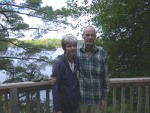 Our (Paul and Kitty Antonik Wakfer) June "formal" photo was taken June 3, and although the black flies here in rural Ontario had begun to be bothersome the month before, we found the deck to be free of them that late morning.
Our (Paul and Kitty Antonik Wakfer) June "formal" photo was taken June 3, and although the black flies here in rural Ontario had begun to be bothersome the month before, we found the deck to be free of them that late morning. 
 Our (Paul and Kitty Antonik Wakfer) June "formal" photo was taken June 3, and although the black flies here in rural Ontario had begun to be bothersome the month before, we found the deck to be free of them that late morning.
Our (Paul and Kitty Antonik Wakfer) June "formal" photo was taken June 3, and although the black flies here in rural Ontario had begun to be bothersome the month before, we found the deck to be free of them that late morning.
The wood cutting task that we'd started in May was far from finished as June began. But before getting back to that storm damaged (and then electric company downed) tree Paul wanted to create more space for the many split logs that would result.
As with some of the others used to keep the stacks of fire wood from sitting on the wet ground, this was a pallet that we'd retrieved from the wood/brush dump just a couple miles away inside Harcourt Park. (Others Paul constructed from pre-used wood.) While someone else obviously saw no value in them, Paul knew that they would be useful for the firewood pile. This one had only a single support in the middle, definitely insufficient for the weight of the cut wood. Additional pre-used intact 2x4s were added.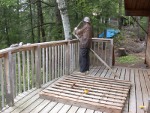

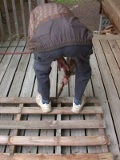
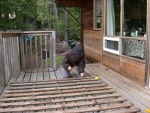

We carried the pallet over to the wood pile, going around the berry patch (mostly blackberry now) to the left, where we had previously rolled another of the large rounds from the tree felled last October. The area at the rear of the wood stack needed some prep work first.
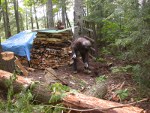
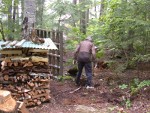
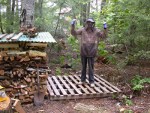
Paul points out to Kitty the precariousness of the stack's upper portion right corner. 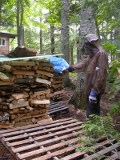
Paul figures that the new pallet will get filled during the summer with wood still left to be cut and chopped.
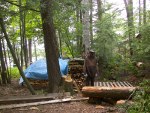
Kitty wanted to make sure that readers didn't think that she just stood around and photographed Paul doing the wood chopping. She set up the camera with a delay for shots where she and Paul were jointly working, but here she enlisted Paul to man the camera while she swung the newer 8lb axe. She found that if she did not put one hand further up the handle, she couldn't get a high swing - she'd fall backward.... And if she used the lighter axe she didn't make much of a cut. She'd actually chopped a few smaller logs before deciding to take on the cherry with a knurl - we'd brought the entire piece back from where we'd cleared it off a stand of raspberry canes about 1/2 mile further up the road.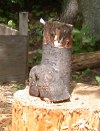
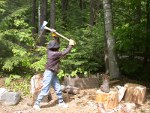
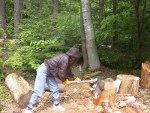
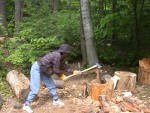
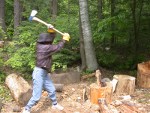
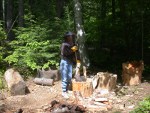
Kitty did lots of wood carrying from the chopping area, but left the arranging mostly to Paul - he just did a much better job of fitting all the pieces so that the layers were even. Besides, he could reach a lot further too as the stack got higher. 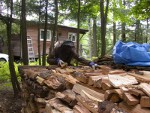

Paul also decided to make use of most of space on the inside of the existing "L" shaped wood stack by adding - and then filling - a small pallet before starting to stack on the newest large pallet.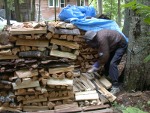
The old wood pile (seen in last of 1st set of photos from previous September) was an item Paul was very glad to get rid of. With that wood either moved to the new stack, burned immediately or simply mulched if too deteriorated, the space began to look more inviting for mushroom foraging and walks back and forth to our neighbors, the Scotts. The small branches and twigs were separately boxed for use as kindling.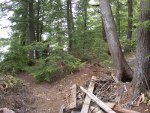
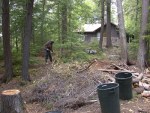
June 15th, two days after the previous 10 photos were taken, we were back at the remainder of the tree trunk alongside the blackberry patch. It was our goal to get it sufficiently cut to bring back home. A lever and our strength were barely enough to get this largest diameter portion of the trunk onto a smaller round we'd kept aside for that purpose. The road edge dip, rocks and the hillside compounded the difficulty of getting the trunk positioned properly - getting continuous good positions for sawing was not possible; taking turns sawing was a necessity. Then add the annoyance of the black flies and the picture of an arduous task is hopefully clear - all to save the blackberry patch for later picking, not leave a mess and make use of the wood. 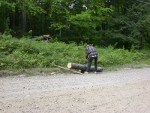
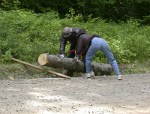
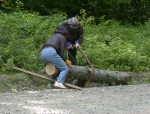
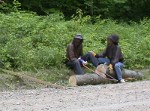
Getting this first (this time) cut piece into the car took far less time then cutting it! Paul needed a bit of help getting a good grip and then Kitty hurried to take a snapshot as he neared the car. We estimated this piece weighed about 80lbs.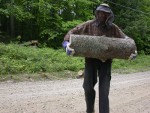
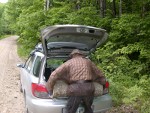
Another 30 minutes worth of sawing and the 2nd cut was done; we found that getting low to the ground while sawing was a necessity.
The last 2 pieces were just a bit too heavy for Paul to get a grip on even with Kitty's help. So instead, an end-over-end approach was taken.
 With the back seat of the car down, all 3 pieces fit flat with plenty of room on top to spare.
With the back seat of the car down, all 3 pieces fit flat with plenty of room on top to spare.

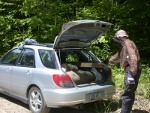
Only the base of the tree on the top of incline remains as an indication that the trunk had fallen - but only we and photo viewers will know the effort taken to keep this portion of the blackberry patch accessible. While there's still more burnable (after drying) wood in that tree, we don't plan to make use of it - at least not this year. 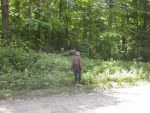

Paul proudly displays (after lugging them from the car) the last 3 double cuts of the tree trunk and the single round we'd cut the time before and then used as the fulcrum. He immediately started in sawing the first of the pieces in half before taking the axe to them.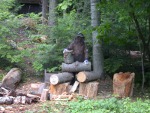
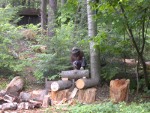
There was lots more sawing and chopping of downed tree trunks and branches both in June and the rest of 6 months in Ontario - but that's enough photos of the work for now....
 |
 |